
Become a member
Join today and help protect nature, beauty and history – for everyone, for ever. Enjoy access to more than 500 places with National Trust membership.
Thousand-year-old royal castle shaped by warfare
The Square, Corfe Castle, Nr Wareham, Dorset, BH20 5EZ
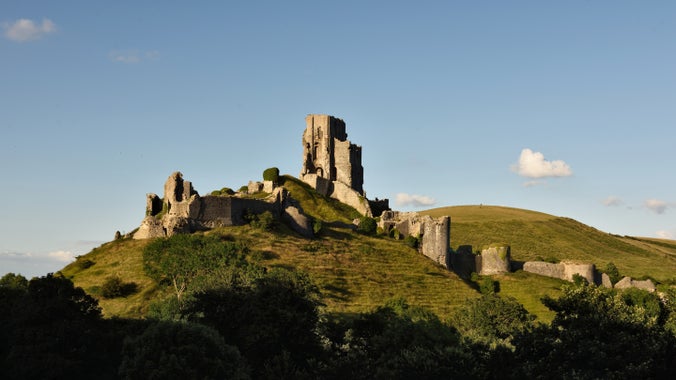
| Asset | Opening time |
|---|---|
| Castle | 07:00 - 16:00 |
| Castle View Welcome Centre | 10:00 - 15:30 |
| Tea-room | 11:00 - 16:00 |
| Shop | 10:30 - 16:00 |
| Car Park | Dawn - Dusk |
| Ticket type | With Gift Aid | Without Gift Aid |
|---|---|---|
| Adult (18+) | £15.40 | £14.00 |
| Child (5-17) under 5s free | £7.70 | £7.00 |
| Family (2 Adults and up to 3 children) | £38.50 | £35.00 |
| Family (1 adult) | £23.10 | £21.00 |
| Group (Adult 18+) | £13.30 | |
| Group (Child 5-17) | £6.65 |
| Ticket type | With Gift Aid | Without Gift Aid |
|---|---|---|
| Adult (18+) | £16.50 | £15.00 |
| Child (5-17) under 5s free | £8.30 | £7.50 |
| Family (2 Adults and up to 3 children) | £41.30 | £37.50 |
| Family (1 adult) | £24.80 | £22.50 |
| Group (Adult 18+) | £13.30 | |
| Group (Child 5-17) | £6.65 |
Within the castle grounds.
Postcode BH20 5DR. 90 spaces including 4 disabled bays.
On short leads at all times.
4 11kW electric vehicle charging points are available. Chargers can be accessed using mobile app, RFID card, or contactless payment device. Visit our EV charging provider RAW Charging’s website (www.rawcharging.com/drivers) to download the app in advance of your visit.
As part of the Caring for Corfe Castle Conservation project guided tours, and access to the Kings' View tower, are available most week days (outside of school holidays). Please check the events section of the website for further information and availability.
Please contact info@especially4you.co.uk for more information.
Conveniently placed close to the castle entrance, with a unique range of gifts, books, toys, local produce and clothing.
Cosy 18th-century Tea-room and garden with unique close-up views of the castle.
Toilets are available at the Welcome Centre, Ticket Office and at the Tea-room.
Steep slopes, steps and uneven paths throughout the site. The castle is a ten-minute walk from main car park. There are walking sticks available to hire and an access guide. Designated mobility parking and accessible toilets available.
A copy can be downloaded from our website, or available in leaflet form on property.
Accessible toilet facilities are available by the Ticket Office, postcode BH20 5EZ.
Changing Places unit at Castle View Welcome Centre. Facility includes an adult-sized changing bench, hoist, a peninsular toilet and a height adjustable basin.
There are four disabled parking bays at Castle View Car Park, postcode BH20 5DR.
Located at Castle View Welcome Centre.
Available in multiple locations across the site.
Multiple steep steps, slopes and uneven surfaces across the site.
Experience the charm of Corfe Castle this Christmas. Explore the ruins to find festive scenes, toast marshmallows around firepits, enjoy family crafting activities or for an extra touch of magic, experience the ambience of the castle at night.

For the first time since 1646 you can ascend the Kings' Tower at Corfe Castle to experience panoramic views and rare historical features - once only reserved for royalty. Book on to one of our tours here.

Our events are designed to ensure everyone has a great day out. Find out more here.

Corfe Castle is the perfect place to enjoy a fun-filled family day out. There is always something new to explore and join in with a jam-packed programme of events.

To ensure as many people as possible can enjoy the historic ruins, discover how we're making Corfe Castle as accessible to all.

Well-behaved dogs on leads are welcome at Corfe Castle all year round. Find out more about where you can take your dog and the facilities available.

Find out everything you need to know about booking a group visit to Corfe Castle, from admission prices to information about school visits.

Perched above a picture postcard village with panoramic views of the Purbeck countryside, the fairy-tale ruins of this 1,000 year old castle make for the perfect setting for your romantic wedding ceremony.

Royal castle established by William the Conqueror and partially destroyed in the English Civil War. Now a majestic ruin.
Gently rolling chalk hills dotted with ancient burial mounds, with views over Poole Bay as far as the Isle of Wight.
Riverside picnic area with picnic tables next to Corfe River.
Cosy 18th-century Tea-room and garden with unique close-up views of the castle.
Conveniently placed close to the castle entrance, with a unique range of gifts, books, toys, local produce and clothing.
Information for your visit to Corfe Castle and the Purbeck Hills, plus second-hand bookshop, hot and cold drinks and snacks.
Experience the charm of Corfe Castle this Christmas. Explore the ruins to find festive scenes, toast marshmallows around firepits, enjoy family crafting activities or for an extra touch of magic, experience the ambience of the castle at night.

For the first time since 1646 you can ascend the Kings' Tower at Corfe Castle to experience panoramic views and rare historical features - once only reserved for royalty. Book on to one of our tours here.

Corfe Castle is the perfect place to enjoy a fun-filled family day out. There is always something new to explore and join in with a jam-packed programme of events.

Walk in the footsteps of eight historical characters, to understand their unique perspective of Corfe Castle
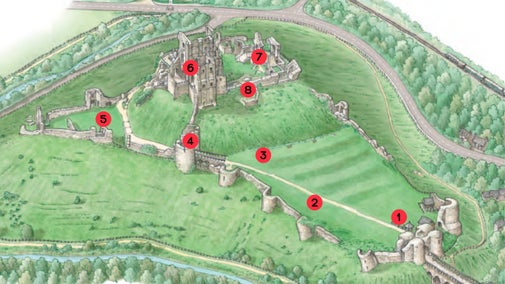
Our events are designed to ensure everyone has a great day out. Find out more here.

Corfe Castle offers plenty to see and do, including walks around the ruins, a audio trail and wildlife spotting in the surrounding hills. Find out more.

Looking after Corfe Castle is a vast and complex task with access being one of the most significant challenges. A three year, £2m conservation project is well under way with a dedicated team working throughout the seasons to ensure the castle endures for future generations.
We’re one of the places featured in series three of BBC Two’s Hidden Treasures of the National Trust. The show goes behind the scenes to hear from the experts who look after treasured objects, including a long-hidden archway at Corfe Castle, in episode 4.
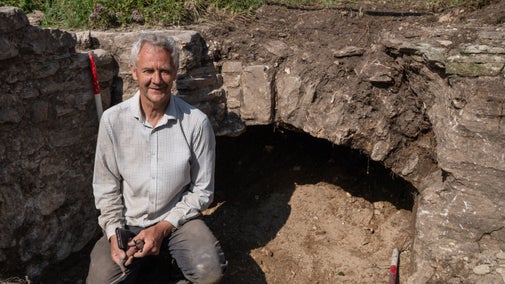
Situated in an 18th century former cottage, the Tea-room at Corfe Castle serves a delicious menu of hot and cold food, drinks, cakes and bakes. Afterwards, stop off at the Shop to discover beautiful collections of homewares, gifts and locally made ranges to take home with you. The second-hand book shop located in Castle View is also filled with literary treasures.

Explore Corfe Common and look out for signs of early human activity at this interesting archaeological landscape near Corfe Castle, Dorset.

This walk along the roof of Purbeck takes in Corfe Castle and Old Harry with the option to return by steam train on the Swanage Railway (when operating).


A simple campsite in a meadow just off the South West Coast Path, with walks inland to the Purbeck hills or to Chapman’s Pool on the Jurassic Coast.
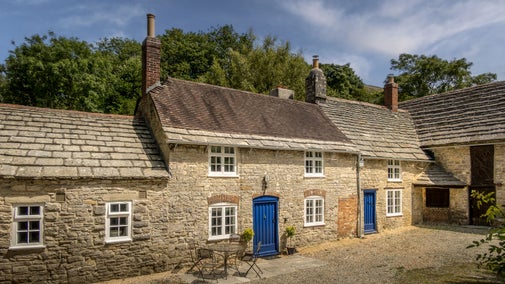
A former bakery, this intriguing and cosy cottage sits close to Corfe Castle with walking trails all around.

Sitting just below Corfe Castle, this thatched cottage has a view of the thousand-year-old ruins from its terrace.

With views over the Purbeck Hills from the bedroom, this unusual cottage makes a quirky escape.

A quirky holiday cottage in a former isolation hospital with amazing views over the Purbeck Hills.

In the shadow of Corfe Castle, this former groom’s cottage is a quirky retreat in a historic village.
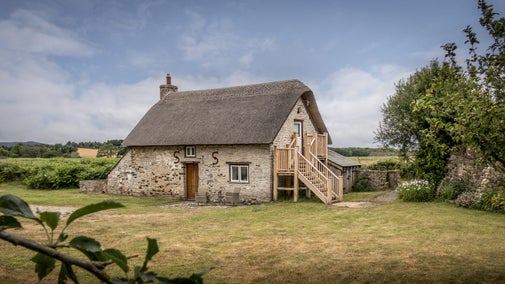
A charming, rustic conversion, this holiday cottage has wonky beams and countryside views.

A cosy cottage attached to the larger farmhouse, with views of open heath and woodland.
Experience the rare opportunity of watching the sun rise over East Hill on the shortest day of the year from the castle ruins.
Experience Winter Solstice like never before from the top of Corfe Castle's keep, where history and stunning views combine. Peacefully watch the first light of solstice appear over the Purbeck Hills on this unique opportunity.
For the first time since 1646, you can ascend the Kings Tower at Corfe Castle to experience rare historical features and panoramic views - once only reserved for royalty.
Experience the charm of Christmas at Corfe Castle, with festive touches and winter moments to enjoy.
Explore the castle this festive season, searching for the festive scenes in the castle.
For the first time since 1646, you can ascend the Kings Tower at Corfe Castle to experience rare historical features and panoramic views - once only reserved for royalty.
One of Britain's most iconic and evocative survivors of the English Civil War, partially demolished in 1646 by the Parliamentarians.
A favourite haunt for adults and children alike, all ages are captivated by these romantic castle ruins with breathtaking views across Purbeck.
Discover 1,000 years of our history as a royal palace and fortress. With fallen walls and secret places, there are tales of treachery and treason around every corner.
Spot the 'murder holes' and count the arrow loops. Feel history come to life and see the wildlife that has set up home here.
Looking after Corfe Castle is a vast and complex task with access being one of the most significant challenges. A three year, £2m conservation project is well under way with a dedicated team working throughout the seasons to ensure the castle endures for future generations.
Corfe Castle has a colourful history spanning more than 1,000 years. During that time, it has seen its fair share of battles and mysteries. Find out how the castle was built and destroyed, and about the people who lived here.

Corfe Castle is always looking for friendly and passionate volunteers to join the team. Volunteers play a big part in caring for the historic ruins and welcoming visitors to Corfe Castle and the wider Purbeck estate.


Join today and help protect nature, beauty and history – for everyone, for ever. Enjoy access to more than 500 places with National Trust membership.
By sharing your email address you’re agreeing to receive marketing emails from the National Trust and confirm you’re 18 years old or over. Please see our for more information on how we look after your personal data.